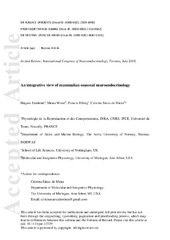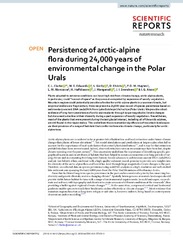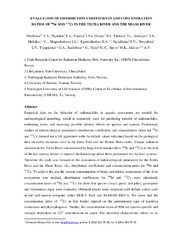Institutt for arktisk og marin biologi: Nye registreringer
Viser treff 1161-1180 av 2084
-
An integrative view of mammalian seasonal neuroendocrinology
(Journal article; Tidsskriftartikkel; Peer reviewed, 2019-05-06)Seasonal neuroendocrine cycles that govern annual changes in reproductive activity, energy metabolism and hair growth are almost ubiquitous in mammals that have evolved at temperate and polar latitudes. Changes in nocturnal melatonin secretion regulating gene expression in the pars tuberalis (PT) of the pituitary stalk are a critical common feature in seasonal mammals. The PT sends signal(s) to the ... -
Persistence of arctic-alpine flora during 24,000 years of environmental change in the Polar Urals.
(Journal article; Tidsskriftartikkel; Peer reviewed, 2019-12-23)Plants adapted to extreme conditions can be at high risk from climate change; arctic-alpine plants, in particular, could “run out of space” as they are out-competed by expansion of woody vegetation. Mountain regions could potentially provide safe sites for arctic-alpine plants in a warmer climate, but empirical evidence is fragmentary. Here we present a 24,000-year record of species persistence based ... -
Temporal and spatial dynamics of the invasive red king crab and native brachyuran and anomuran larvae in Norwegian waters
(Journal article; Tidsskriftartikkel; Peer reviewed, 2020-01-16)This study investigates the temporal and spatial patterns of larval stages of the invasive red king crab <i>Paralithodes camtschaticus</i> (RKC) and co-existing native brachyurans and anomurans in a Norwegian fjord. It is one of few field studies describing the larval stage of native and invasive brachyurans and anomurans in the southern Barents Sea. Larvae were collected at 6 to 18 stations at ... -
Warming and CO2 enhance arctic heterotrophic microbial activity
(Journal article; Tidsskriftartikkel; Peer reviewed, 2019-03-20)Ocean acidification and warming are two main consequences of climate change that can directly affect biological and ecosystem processes in marine habitats. The Arctic Ocean is the region of the world experiencing climate change at the steepest rate compared with other latitudes. Since marine planktonic microorganisms play a key role in the biogeochemical cycles in the ocean it is crucial to ... -
Populasjonssykluser hos hare – drevet av rovdyr og spesielt gaupe
(Journal article; Tidsskriftartikkel; Peer reviewed, 2019-06-27)Snøskohare – og gaupesyklusene i det boreale Nord-Amerika er et av de best kjente eksempler på populasjonssykluser. Sammenlignet med andre sykliske arter har denne syklusen en relativ konstant periode på 9–10 år. Haretettheten varierer typisk 20–30 ganger mellom topp- og bunnår. Mye økologisk forskning har ved hjelp av forskjellige metoder forsøkt å avdekke årsakene til snøskoharesyklusene, også med ... -
Hypoxia Inducible Factor 1α Inhibits the Expression of Immunosuppressive Tryptophan-2,3-Dioxygenase in Glioblastoma
(Journal article; Tidsskriftartikkel; Peer reviewed, 2019-12-04)Abnormal circulation in solid tumors results in hypoxia, which modulates both tumor intrinsic malignant properties as well as anti-tumor immune responses. Given the importance of hypoxia in glioblastoma (GBM) biology and particularly in shaping anti-tumor immunity, we analyzed which immunomodulatory genes are differentially regulated in response to hypoxia in GBM cells. Gene expression analyses ... -
A Multi-Pathogen Screening of Captive Reindeer (Rangifer tarandus) in Germany Based on Serological and Molecular Assays
(Journal article; Tidsskriftartikkel; Peer reviewed, 2019-12-20)Captive reindeer in German zoos and wildlife parks live outside their natural geographic range and are exposed to a variety of viral, bacterial and protozoan pathogens, some host-specific and some which they are not exposed to in their native habitat. Reindeer blood samples and ticks collected in 2013 from 123 reindeer at 16 different zoological facilities were available from a previous study. The ... -
When spring ephemerals fail to meet pollinators: Mechanism of phenological mismatch and its impact on plant reproduction
(Journal article; Tidsskriftartikkel; Peer reviewed, 2019-06-12)The flowering phenology of early-blooming plants is largely determined by snowmelt timing in high-latitude and high-altitude ecosystems. When the synchrony of flowering and pollinator emergence is disturbed by climate change, seed production may be restricted due to insufficient pollination success. We revealed the mechanism of phenological mismatch between a spring ephemeral (<i>Corydalis ambigua</i>) ... -
Maternal Photoperiodic Programming: Melatonin and Seasonal Synchronization Before Birth
(Journal article; Tidsskriftartikkel; Peer reviewed, 2020-01-10)This mini-review considers the phenomenon of maternal photoperiodic programming (MPP). In order to match neonatal development to environmental conditions at the time of birth, mammals use melatonin produced by the maternal pineal gland as a transplacental signal representing ambient photoperiod. Melatonin acts via receptors in the fetal pituitary gland, exerting actions on the developing medio-basal ... -
Identifying climate-sensitive infectious diseases in animals and humans in Northern regions
(Journal article; Tidsskriftartikkel; Peer reviewed, 2019-11-14)<i>Background</i> - General knowledge on climate change effects and adaptation strategies has increased significantly in recent years. However, there is still a substantial information gap regarding the influence of climate change on infectious diseases and how these diseases should be identified. From a One Health perspective, zoonotic infections are of particular concern. The climate in Northern ... -
Pestivirus Infections in Semi-Domesticated Eurasian Tundra Reindeer (Rangifer tarandus tarandus): A Retrospective Cross-Sectional Serological Study in Finnmark County, Norway.
(Journal article; Tidsskriftartikkel; Peer reviewed, 2019-12-26)Members of the Pestivirus genus (family <i>Flaviviridae</i>) cause severe and economically important diseases in livestock. Serological studies have revealed the presence of pestiviruses in different cervid species, including wild and semi-domesticated Eurasian tundra reindeer. In this retrospective study, serum samples collected between 2006 and 2008 from 3339 semi-domesticated Eurasian reindeer ... -
Nature-based tourism, resource dependence, and resilience of Arctic communities: framing complex issues in a changing environment
(Journal article; Tidsskriftartikkel, 2019-05-16)Current research on tourism in the Arctic has focused largely on the extent, location, and type of tourism activities that occur in the region. Recently, challenges have been identified that the tourism industry is likely to face in the wake of global changes, including climate change. Related research, conducted within and outside of the Arctic, suggests that rural communities can become economically ... -
Flexibility in a changing arctic food web: Can rough-legged buzzards cope with changing small rodent communities?
(Journal article; Tidsskriftartikkel; Peer reviewed, 2019-08-07)Indirect effects of climate change are often mediated by trophic interactions and consequences for individual species depend on how they are tied into the local food web. Here we show how the response of demographic rates of an arctic bird of prey to fluctuations in small rodent abundance changed when small rodent community composition and dynamics changed, possibly under the effect of climate ... -
Hiding in the background: community-level patterns in invertebrate herbivory across the tundra biome
(Journal article; Tidsskriftartikkel; Peer reviewed, 2019-09-03)Invertebrate herbivores depend on external temperature for growth and metabolism. Continued warming in tundra ecosystems is proposed to result in increased invertebrate herbivory. However, empirical data about how current levels of invertebrate herbivory vary across the Arctic is limited and generally restricted to a single host plant or a small group of species, so predicting future change remains ... -
The radiation exposure of fish in the period of the Techa river peak contamination
(Journal article; Tidsskriftartikkel; Peer reviewed, 2019-02-10)Waterborne radioactive releases into the Techa River from the Mayak Production Association in Russia during 1949–1956 resulted in downstream contamination of the river ecosystem. The discharged liquid waste contained both short-lived isotopes (95Zr, 95Nb, 103,106Ru, 141,144Ce, 91Y, 89Sr and 140Ba with half-life from 3 days to 1.02 years) and the long-lived 90Sr and 137Cs (half-life - 28.79 y and ... -
Sticky mucilages and exudates of plants – putative microenvironmental design elements with biotechnological value
(Journal article; Tidsskriftartikkel; Peer reviewed, 2019-09-24)Plants produce a wide array of secretions both above and below ground. Known as mucilages or exudates, they are secreted by seeds, roots, leaves and stems and fulfil a variety of functions including adhesion, protection, nutrient acquisition and infection. Mucilages are generally polysaccharide‐rich and often occur in the form of viscoelastic gels and in many cases have adhesive properties. In some ... -
Assessing the effect of predator control on an endangered goose population subjected to predator-mediated food web dynamics
(Journal article; Tidsskriftartikkel; Peer reviewed, 2019-01-29)<ol> <li>Assessing the effectiveness of conservation actions to halt population declines is challenging when confounded by other factors. We assessed whether culling of red fox, a predator currently increasing in number in the sub‐Arctic, contributed to recent recovery of the critically endangered Fennoscandian population of Lesser White‐fronted Goose <i>Anser erythropus</i>, while controlling for ... -
High resistance to climatic variability in a dominant tundra shrub species
(Journal article; Tidsskriftartikkel; Peer reviewed, 2019-06-05)Climate change is modifying temperature and precipitation regimes across all seasons in northern ecosystems. Summer temperatures are higher, growing seasons extend into spring and fall and snow cover conditions are more variable during winter. The resistance of dominant tundra species to these season-specific changes, with each season potentially having contrasting effects on their growth and survival, ... -
Arctic greening and bird nest predation risk across tundra ecotones
(Journal article; Tidsskriftartikkel; Peer reviewed, 2019-07-01)Alarming global-scale declines of bird numbers are occurring under the changing climate, and species belonging to alpine and Arctic tundra are particularly affected. Increased nest predation appears to be involved4, but the mechanisms linking predation to climate change remain to be shown. Here we test the prediction from food web theory that increased primary productivity (greening of tundra) in a ... -
Spatial synchrony in sub-arctic geometrid moth outbreaks reflects dispersal in larval and adult life cycle stages
(Journal article; Tidsskriftartikkel; Peer reviewed, 2019-02-08)<OL> <LI>Spatial synchrony in population dynamics can be caused by dispersal or spatially correlated variation in environmental factors like weather (Moran effect). Distinguishing between these mechanisms is challenging for natural populations, and the study of dispersal‐induced synchrony in particular has been dominated by theoretical modelling and laboratory experiments. <LI>The goal of the ...


 English
English norsk
norsk


















